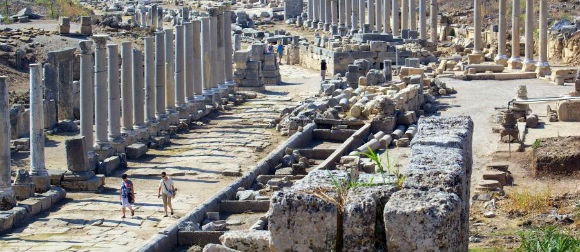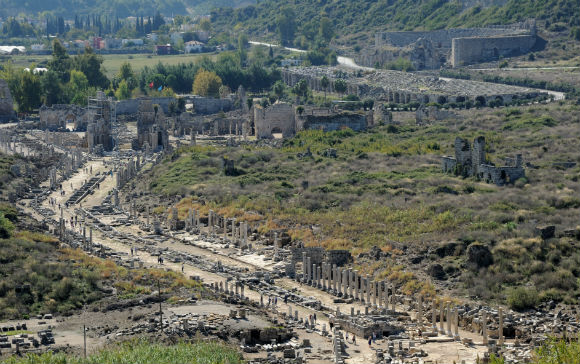The most impressive ruins of the Pamphylian coast are at Perge, at about 15 km east of Antalya. Perge was originally founded by the Hittites around 1500 BC. and was known as Parha. It was a successful trading centre near the Aksu (ancient Kestros or Cestrus) river when Alexander the Great arrived in 333 BC. He was welcomed in by the inhabitants and used Perge as base for his Anatolian campaigns. Alexander was followed by the Seleucids under whom the city prospered and Perge’s most celebrated inhabitant, the mathematician Apollonius from Perge lived and worked. Apollonius was a pupil of Archimedes and wrote a series of eight books on geometry. In 188 BC Perge became part of the Roman Empire during which the city flourished. Most of the surviving buildings date from this period.In 46 AD St. Paul started his journey in Perge (biblical Perga) and preached his first sermon here. Perge gradually declined during the Byzantine period, as the Aksu river silted, but remained inhabited until Selçuk times after which it became abandoned.
A visit to Perge starts by entering the archeological site through the Roman Gate, built during the reign of Septimius Severus (193-211 AD). Proceeding through the gate, to the right is the Agora or market place. This structure of 75 x 75 m dates back from the 2nd century AD. The center courtyard and shops were surrounded by a wide stoa, a covered walkway. The floor of the stoa and shops was made of colored mosaics. The agora was not only the centre of Perge’s trade, but was also a place for meetings as well as a forum for political, social, and philosophical discussions. The next building is the Hellenistic city gate that dates back to the 3rd century BC. This is certainly the most imposing building of the city and was cleverly designed to protect the city with its twin towers and its horseshoe-shaped courtyard at the back. It is thought that the towers had three floors and were crowned by a conical roof. In the year 121 AD, the horseshoe-shaped courtyard was rededesigned as a courtyard of honor. Behind the courtyard stood a triple arch. Around the arch there are about dozen inscriptions connected with Plancia Magna who lived in the 2nd century AD. She was the daughter of the governor, a priestess of Artemis Pergaia (Diana) and a benefactress to the city. Plancia Magna had the arch decorated with the statues of the emperors and their relatives.
After passing through the Hellenistic Gate and courtyard, one enters a broad, marble-paved double-colonnaded street measuring 300 meters in length that extends from the main gate to the acropolis. The street is 20 m wide and is divided in two by a 2 meter wide water channel running down the middle. At the end of the colonnaded street is the Nymphaeum, a triumphal fountain from where a stream flowed down into the water channel. The nymphaeum or nymphaion is an ornamental semicircular structure and dates from the reign of Emperor Hadrian (130-150 AD). A statue of a river god Kestros was located in the center of this huge fountain. Behind the nymphaeum is the acropolis with some remains of the Byzantine period. To the west of the nymphaeum are the remains of a palaestra dating from 50 AD and dedicated to the Emperor Cladius (41-54 AD).
Returning back to the entrance, there are the excavated Roman baths located southwest to the agora. Out of the site proper, is the horsehsoe-shaped stadium, the largest in Asia Minor, measuring 234 m by 34 m. The stadium had a seating capacity of 12,000 people supported by massive barrel-vaulted constructions. Just beyond the site entrance is also the theatre, which is of the Greco-Roman type and could seat 15,000 people. Unfortunately, it is for some time under reconstruction and unfortunately closed to visitors.
Perge,



We have visited many ancient sites, and this one stacks up nicely with most of them. Strong points: carefully excavated and well-signed in English, lots to see, unrestricted access to everything in the site, relatively few other tourists when we went. Weak areas: no tour guides available when we were there (although the well-signed site really doesn't need one), few…
if you like history and ruins this place is a definite. we went on a tour to here, side, aspendos and the waterfall. a very enjoyable day.
This was part of our day trip and was the least memorable albeit still quite grand in scale. We had seen most of Perge's restored statues at the Antalya museum and our guide had noted that most of what Perge had to offer was at the museum and much had yet to be discovered due to a lack of funding…
beautiful site, small, quiet. good for a one hour stay. ugly threads
from electricity disturb the view, unfortunally
Agora, collonaded street, bath-house,stadium and nymphaeum all splendid.
Only a short walk up the road from Aksu village where the minibus from Antalya drops you. Theatre and palaestra unfortunately currently closed for restoration.
There are lots of ruins across Turkey to see, and there are better preserved or restored than Perge. However if you are in Antalya then they are worth a visit. The Baths are great and so is the Stadium. One of the best Stadiums I have seen that has not been restored fully.
Both very interesting and worth the visit. Easy to get to on public transport and a lot cheaper than a tour.
Loved Perge and Aspendos! Had a really good guide who brought it all to life for us, fascinating! (tomson). Do not support the use of the poor Camels the man has kneeling on concrete at Aspendos! Poor creatures!
I must agree with many other reviewers that this would be a better site if there was more information. However even without a guide this is a very impressive and very large collection of ruins, essentially an entire town, which was reportedly one of the most beautiful cities of the Hellenistic era ca. 300 BC, but was also occupied by…
Extremely interesting walk around a 2000 year old city, brought to life by our guide.
See the inside and outside baths of this Roman City, stroll around the market square, walk along the colonnades
Great number of interesting pillars.
Amazing the sheer size of the original city.
The location is near Anatolia
We combined this with a trip to Aspendos,…